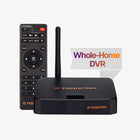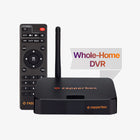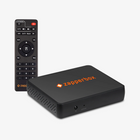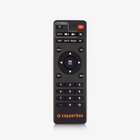Should you buy an ATSC 3.0 or ATSC 1.0 DVR for 2024?
ZapperBox NEXTGEN TV dual tuner DVR, with lifetime guide data subscription and 512GB microSD card is priced $432 at https://zapperbox.com/. TiVo subscription-free dual tuner ATSC 1.0 DVR with 500GB internal HDD is priced $449 at https://www.channelmaster.com/. Prices checked on December 1, 2023.
It is going to be 2024 soon. Should you spend slightly less money to buy an ATSC 3.0 capable DVR or a bit more for an ATSC 1.0 DVR during 2024? Most industry pundits are recommending that you wait. As a maker of the only shipping ATSC 3.0 DVR, we’d like to share the reasons why you should not buy an ATSC 1.0 DVR anymore.
Let us start with a historical analogy. The iPhone was introduced in 2007 when the dominant smartphones were the Blackberry and the Palm Pilot. If this were 2008, would you buy an iPhone or a Blackberry?
Now, consider how long your typical ATSC DVR will last. Our best guess is about 5 to 10 years. When will ATSC 1.0 service start to sunset? The current FCC rules state that after July 17, 2027, broadcasters will be allowed to exceed their ATSC 3.0 programming beyond what they offer on their ATSC 1.0 broadcasts. This means that in about three years, you will be able to see programs on ATSC 3.0 that will not be available on ATSC 1.0 channels.
When will ATSC 1.0 broadcasts be turned off? The FCC has not announced this yet. But let us get some perspective from the analog to digital transition. The first experimental ATSC 1.0 broadcasts started in 1996, the NTSC sunset date was announced seven years later in 2003, and all analog broadcasts were switched off in 2009 – 13 years after the first broadcast. In comparison, the first ATSC 3.0 experimental broadcast started in 2017. Seven years will be up in 2024, and almost right on schedule, some guidance is expected from the FCC in 2024 about the transition and sunset plan. If the 13-year analogy holds, we will see the last ATSC 1.0 broadcast in 2030.
Based on these numbers, your ATSC 1.0 DVR will start getting less programming in three years, and in six years it will become useless. The ATSC 3.0 DVR that you buy today, meanwhile, will still be going strong because it can handle both ATSC 1.0 and ATSC 3.0 broadcasts.
Now let us look at some of the cool capabilities that ATSC 3.0 brings to you, which will never be available on ATSC 1.0.
Dolby AC-4: ATSC 3.0 uses the Dolby AC-4 standard, while ATSC 1.0 is based on the older Dolby AC-3 audio standard. The old standard offers Dolby 5.1 surround sound while Dolby AC-4 offers Dolby 7.1.4 three-dimensional sound, also known as Dolby Atmos. The third axis adds sound effects above and below the listener in addition to the surround sound in the X-Y plane. The difference is astounding.
Dolby AC-4 also offers some more interesting features:
- Sound leveler to control sudden volume changes.
- Dialog enhancement to improve the dialog during scenes with a lot of background noise.
- An unlimited number of audio tracks that can be brought in over the Internet and synchronized with the video.
- Descriptive audio that can carry audio narration for vision-impaired persons.
COFDM Modulation: ATSC 3.0 signals use COFDM modulation. This is a big change from the 8-VSB modulation used for ATSC 1.0. COFDM is the same modulation used for 5G mobile phones. It is much more resistant to multi-path interference, a problem that has plagued ATSC 1.0 signals since its inception. Multi-path interference is a problem not only in big cities with tall buildings. It is also a problem that affects indoor antennas after the TV signal enters a home and bounces off walls within the home. In general, ATSC 3.0 signals will be more robust and provide a better viewing experience.
Single Frequency Networks: COFDM modulation lends itself to the installation of multiple TV towers on a single frequency with synchronized radio waves. Think of this like the Wi-Fi mesh network in your home but at a metropolis level. No matter where you travel within a city, you will always get a good TV signal and there will be no dead spots. San Francisco has already installed a ring of five synchronized TV towers around the main tower atop the Presidio. No more dead TV spots in San Francisco for ATSC 3.0 viewers. The SFN concept is now being taken a step further by wiring up the entire interstate system with ATSC 3.0 towers so that entertainment and data can be broadcast to receivers in moving cars all along the freeway system!
MPEG to Internet: ATSC 1.0 carried programming in 188-byte MPEG packets. MPEG is decoded in hardware, and once you purchase your TV or DVR, no innovation is possible. In contrast, ATSC 3.0 data is carried in IP packets and decoded using software just like on your smartphone or laptop. When new standards are introduced, the software on your TV or DVR can be updated accordingly.
Interactivity: ATSC 3.0 supports applications written in HTML5, CSS, and JavaScript, just like your smartphone and laptop. These applications will allow broadcasters to offer innovative interactive features to viewers. Some early examples have been interactive stats during sporting events and enhanced weather information. Other possibilities include the ability to rewind or binge-watch a broadcast event using your Internet connection.
Internet Channels: ATSC 3.0 supports the concept of streaming channels that are advertised within the grid guide, but when you tune to them, they stream over the Internet. This will allow broadcasters to carry an unlimited number of channels and satisfy the needs of niche markets, such as broadcasting local school board meetings. Internet channels will also play a crucial role during the transition from ATSC 1.0 to ATSC 3.0, when broadcast spectrum will be at a premium. True 4K content may first appear on Internet channels rather than on broadcast channels, where bandwidth is limited during the ATSC 1.0 simulcast mandate.
Video quality: Finally, the most obvious advantage of ATSC 3.0 is picture quality. While ATSC 1.0 offers HD video for screens with two million pixels, ATSC 3.0 offers UltraHD video for screens with eight million pixels, also called 4K. ATSC 3.0 also makes use of the matrix backlighting found on newer TVs to offer 10-bit High Dynamic Range (HDR) video with much more stunning colors than the 8-bit video seen on older HD TV sets.
I will close with another analogy: Blu-Ray players were released on June 6, 2006. It is now 2008, would you buy a regular old DVD player or a Blu-Ray? Happy shopping.





